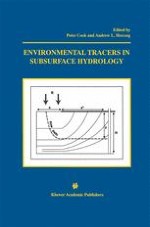
2000 | OriginalPaper | Chapter
Determining Timescales for Groundwater Flow and Solute Transport
Authors : Peter G. Cook, John-Karl Böhlke
Published in: Environmental Tracers in Subsurface Hydrology
Publisher: Springer US
Included in: Professional Book Archive
Activate our intelligent search to find suitable subject content or patents.
Select sections of text to find matching patents with Artificial Intelligence. powered by
Select sections of text to find additional relevant content using AI-assisted search. powered by
One of the principal uses of environmental tracers is for determining the ages of soil waters and groundwaters. (We may refer to this as ‘hydrochronology’by analogy with the dating of solid materials known as geochronology.) Information on soil water and groundwater age enables timescales for a range of subsurface processes to be determined. For example, ‘groundwater stratigraphy’is used increasingly to decipher past recharge rates and conditions in unconfined aquifers, in much the same way that sedimentary stratigraphy yields information about past depositional environments. The use of environmental tracers to determine water ages allows groundwater recharge rates and flow velocities to be determined independently, and commonly more accurately, than with traditional hydraulic methods where hydraulic properties of aquifers are poorly known or spatially variable. Studies of groundwater residence times in association with groundwater contamination studies can enable historic release rates of contaminants and contaminant transport rates to be determined. Where input rates are known, measurements of groundwater contaminant concentrations, together with groundwater dating, can sometimes be used for estimating chemical reaction rates. The combination of these dating methods with stable isotope measurements has sometimes allowed changes in contaminant sources over time to be determined.